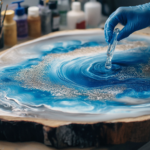Exactly How to Make Epoxy Ocean Water: A Step-by-Step Guide …
In DIY, epoxy material has actually ended up being a go-to tool for creating spectacular, durable artwork and projects. Among its several uses, one of the most aesthetically striking applications is crafting sea water scenes. Making use of material’s openness and capability to hold colors, you can replicate the mesmerizing appearance of waves, sea depths, and beach foam. Whether you’re enhancing a furniture, developing a beachy wall surface decoration, or including measurement to woodworking, discovering exactly how to make epoxy sea water is both an art kind and a fun craft activity.
In this guide, we’ll give a detailed walkthrough on exactly how to accomplish professional-looking sea water effects with epoxy resin. Every step will certainly be plainly described, from collecting materials to applying wave patterns. By the time you’re done, you’ll have a gorgeous development and a much deeper understanding of the process that can inspire future tasks. Let’s get started on your innovative journey into epoxy ocean art!
What You’ll Need to Make Epoxy Ocean Water
Prior to you begin your project, it’s vital to have all the needed materials handy. Having every little thing ready will conserve you time and guarantee the material doesn’t begin healing while you’re clambering for materials. The important product, naturally, is epoxy material, however to bring the ocean result to life, you’ll likewise require colored pigments or material dyes. Blue and white are the primaries but feel free to add greens for an additional reasonable layer. Disposable blending sticks and mugs will certainly make clean-up simpler and stop cross-contamination in between colors.
A warmth weapon or blowtorch is additionally essential for eliminating bubbles and controling the material to create waves. Bear in mind to cover your workspace with drop cloths or papers to capture any kind of spills. Because epoxy material can be dangerous if inhaled, proper security equipment like gloves, an apron, and a respirator is very advised. If you add attractive components like sand, shells, or rocks, have them ready and nearby to location prior to the material solidifies.
Step-by-Step Guide to Making Epoxy Ocean Water
| Step | Description |
| 1. Prepare Your Workspace | Establish a clean, dust-free office. Ensure your job surface is level. Use drop cloths and protective gear (handwear covers, apron, respirator). |
| 2. Mix Your Epoxy Resin | Integrate epoxy resin and hardener in the required amounts, usually 1:1 or 2:1.
Epoxy material consists of 2 parts: resin and hardener, and these have to be mixed at a precise ratio to make certain correct healing. Using warm to the resin causes it to slim and move, permitting you to shape and guide the white resin to create wave patterns. Epoxy resin commonly takes 24-48 hours to solidify totally, though this can differ based on temperature, moisture, and the certain brand of resin you’re making use of. In this guide, we’ll provide a comprehensive walkthrough on just how to achieve professional-looking ocean water effects with epoxy material. The essential material, of course, is epoxy material, however to bring the sea effect to life, you’ll also require colored pigments or resin dyes. Epoxy material consists of 2 parts: material and hardener, and these should be mixed at a specific ratio to make certain proper treating. Applying warm to the material triggers it to slim and move, permitting you to form and direct the white resin to create wave patterns. Epoxy material usually takes 24-48 hours to solidify completely, though this can differ based on temperature level, moisture, and the certain brand name of material you’re utilizing. |

Leave a Reply